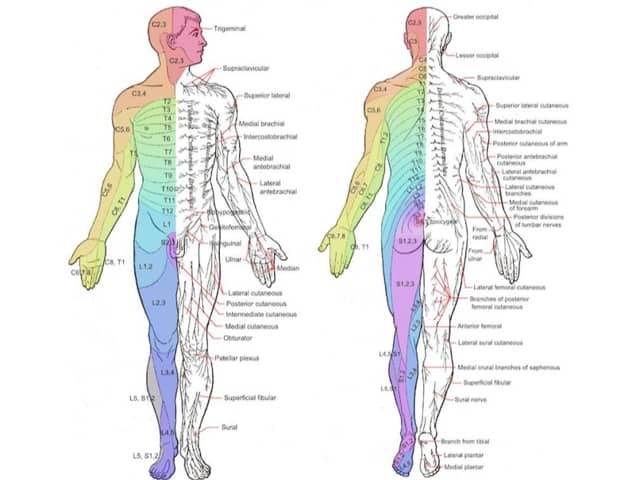Main menu
Common skin conditions

NEWS
Join DermNet PRO
Read more
Quick links
Dermatomes — extra information
Dermatomes
Authors: Claire Jordan Wiggins, Riyad N.H. Seervai, Medical Students, Baylor College of Medicine, Houston, TX, USA. DermNet Editor in Chief: Adjunct A/Prof Amanda Oakley, Dermatologist, Hamilton, New Zealand. Copy edited by Gus Mitchell. June 2020.
What is a dermatome?
A dermatome is an area of skin that is primarily supplied by a single nerve root: communicating sensation from this skin region to the brain. Somatosensation includes feedback from mechanoreceptors, thermoreceptors, proprioceptors, pain receptors, and chemoreceptors. Dermatomes are different from Blaschko lines.
Maps of dermatomes are not consistent, and variation will be noted between different sources.

Credit: https://www.grepmed.com/images/2963/dermatomal-dermatomes-diagnosis-cutaneous-anatomy-nerves-roots
Where are dermatomes located?
Dermatomes form a stack of horizontal layers on the trunk and run lengthwise in the extremities.
- There are eight cervical nerves (although C1 does not have its own dermatome), 12 thoracic nerves, 5 lumbar nerves, and 5 sacral nerves.
- The 5th cranial nerve is divided into three divisions; V1, V2, and V3, which are responsible for sensation in the face.
- Contiguous dermatomes overlap, and each individual’s exact dermatomal pattern is unique.
What is the clinical relevance of dermatomes?
Knowledge of dermatomes can aid in the diagnosis of disease.
- Herpes zoster (shingles), a viral infection caused by varicella-zoster virus. The virus can lie dormant in the spinal nerve ganglia, producing a rash and pain along the corresponding dermatome.
- Lumbar radiculopathy, a radiating back pain extending down a dermatome is due to compression of a spinal nerve root (sciatica).
- Referred pain from a visceral organ can be perceived at a location other than the site of the stimulus or origin in a nearby dermatome.
References
- Whitman PA, Adigun OO. Anatomy, Skin, Dermatomes. 2019. Available at: www.ncbi.nlm.nih.gov/pubmed/30571022 [accessed February 4, 2020].
- Cohen KR, Salbu RL, Frank J, Israel I. Presentation and management of herpes zoster (shingles) in the geriatric population. P T. 2013;38(4):217-27. PubMed Central
- Gore S, Nadkarni S. Sciatica: detection and confirmation by new method. Int J Spine Surg. 2014;8:15. doi:10.14444/1015. PubMed
- Furman MB, Johnson SC. Induced lumbosacral radicular symptom referral patterns: a descriptive study. Spine J. 2019;19(1):163-70. doi:10.1016/j.spinee.2018.05.029. PubMed
- Lee MW, McPhee RW, Stringer MD. An evidence-based approach to human dermatomes. Clin Anat. 2008;21(5):363-73. doi:10.1002/ca.20636. PubMed
- Saguil A, Kane S, Mercado M, Lauters R. Herpes zoster and postherpetic neuralgia: prevention and management. Am Fam Physician. 2017;96(10):656-63. PubMed
- Downs MB, Laporte C. Conflicting dermatome maps: educational and clinical implications. J Orthop Sports Phys Ther. 2011;41(6):427-34. doi:10.2519/jospt.2011.3506. PubMed
On DermNet
Other websites
- Dermatomes — Healthline
- Dermatomes — EMedicineHealth
- Dermatomes — ScienceDirect
